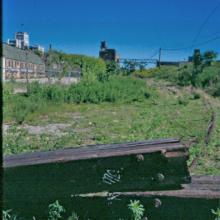861 Hits for February 2013
Albums (0) & Images (861)
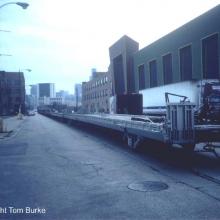
tb_circustrain_111996_01
It's an overcast, grey November day in Chicago and the sun is beginning to set. This view looks southeast down Kingsbury, just south of North Avenue. In the distant background is the white Montgomery Ward headquarters tower. Just a little more than five years earlier trains used to run past Montgomery Ward on the way to the southern end of the line at Grand Avenue. Already the area is in the process of gentrification as witnessed by the modern office building on the right (west).tb_circustrain_111996_01

tb_circustrain_111996_02
Looking north this time on Kingsbury, a truck is unloading across the former CP Rail main track and a spur track at Carbit Paints, a former Milwaukee Road rail customer. The circus train is just ahead.tb_circustrain_111996_02
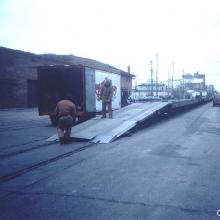
tb_circustrain_111996_03
The last trailer is unloaded, and the crew picks up the ramp on the end of the flatcar. Note the Ringling Bros. logo on the trailer. The ramp is also cut out to accomodate the rails.tb_circustrain_111996_03
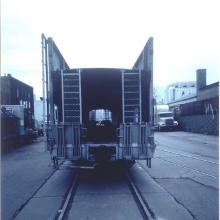
tb_circustrain_111996_05
Another view of the other, north end of the circus train. Note the spent fuses used to signify the stopping point for the locomotive crew. To the right is a former industrial spur that leads nowhere at this date. Farther back and to the right is the still active Midwest Zinc spur with a pair of boxcars spotted there. Midwest Zinc would be gone within a few years too, a victim of the changing neighborhood from industrial to retail and commercial.tb_circustrain_111996_05
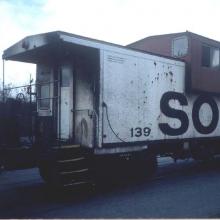
tb_circustrain_111996_07
At the far south end of Kingsbury, near where it bends toward Halsted, a Soo Line caboose stands ready for the switching maneuvers required to move the circus train back out after the shows are over and the trailers are back on the flatcars. It was used during the backup move down Kingsbury from the CP Rail's Bloomingdale line.tb_circustrain_111996_07
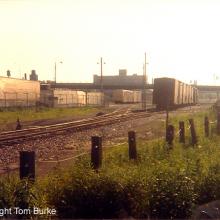
tb_CNWNavyPier_1988_19
We're looking west towards the C&NW Hubbard St. yard with Des Plaines Avenue in the background on the overpass. To the right or north is Kinzie Street and we are standing just off Clinton St. The boxcars were dropped off using the wye by Blommer Chocolate and await a shove to the Sun-Times printing plant. You can just make out one segment of the wye where the track crosses Kinzie St. In the distance to the left or south are refrigerated cars on former Milwaukee Road yard tracks which will be delivered by a Soo Line patrol inside the building at Carroll Ave. and Morgan St. An example of this switch job is shown elsewhere on this website. The Milwaukee Road's freight station was to the left, just out of view. The Pennsylvania Railroad's Panhandle Line was the third railroad in this corridor. It served the unique, rounded Braun Bottle factory on Canal St. by the viaduct and its successors continued to handle the ADM plant half mile west of here through today. In a few years, this C&NW yard would be gone.tb_CNWNavyPier_1988_19

tb_CNWNavyPier_1988_20
A C&NW crew member flags Clinton Ave. as the train made up of boxcars for the Sun-Times is shoved east under the Metra viaduct.tb_CNWNavyPier_1988_20
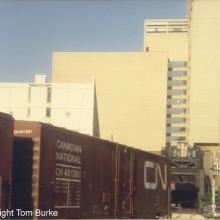
tb_CNWNavyPier_1988_21
The train pauses to wait until the bascule bridge is fully lowered and locked into place before proceeding. In the background is the Apparel Center which was built using air rights over this C&NW branch line. In the foreground is Canal St. To the left, above the boxcars, are relatively new condos built along the North Branch of the Chicago River with their own docks-the first in a wave of residential developments that would take over the area over the next fifteen years. In April of 1992 the Chicago River flooded the former Chicago Tunnel railroad system where it crossed under the river just in front of these new condos and by the Kinzie St. bridge. Pilings were apparently driven into the wrong location which damaged the tunnel wall, leading to a cave in a few months later and the hidden flood that shut down Chicago's Loop for days. The freight tunnel system at one time used narrow-gauge, electric locomotives to link downtown businesses via sub-basement docks for parcel pickup, removal of ashes, and more. Connections were made with regular railroads at various transload locations. Service ended in the late 1950s. Later the tunnels took on a second life as corridors for utility lines. For more information on the Chicago Tunnel railroads see Bruce Moffatt's excellent book "Forty Feet Under" published by the Central Electric Railfans Association (CERA).tb_CNWNavyPier_1988_21
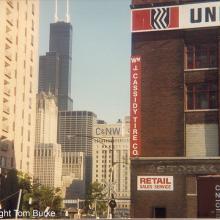
tb_CNWNavyPier_1988_22
This view looks south down Canal St and captures action on the C&NW's Navy Pier line as well as the C&NW's headquarters several blocks away. Looks like a truck knocked off one of the warning lamps on the grade crossing signal. Just a few feet past the Navy Pier line is the former Milwaukee Road C&M mainline which headed west from Chicago. This mainline today sees a lot of traffic from Metra and Amtrak. Freights used a pair of tracks to pass through Union Station on transfer runs.tb_CNWNavyPier_1988_22

tb_CNWNavyPier_1988_23
The bascule bridge slowly lowers and attracts the interest of passersbys. Looks like they are headed to the nearby East Bank Club which was built on the site of the Milwaukee Road's C&E line and approach to the one-time bobtail bridge the C&E used to cross the river by Kinzie St. This C&NW bridge still stands and has two sets of tracks, reflecting an era when the line saw a lot more traffic, including passenger trains which terminated on the east side of the river, where the Merchandise Mart stands. In early 2002 Union Pacific ended service on the line when the Sun-Times switched production to a new facility on the South Side. There's still talk from time-to-time about reviving this dormant rail corridor for light-rail use or as a dedicated, express bus route. Right where the pedestrians are walking was the southern end of the Milwaukee Road's C&E line which paralled Canal St. and linked up with the main tracks just to the right or south. This section of track was removed by the Milwaukee Road in 1973 and the C&E was dead-ended at Grand Avenue.tb_CNWNavyPier_1988_23

tb_CNWNavyPier_1988_24
The first Mystery Photo in context! Getting ready to finally shove the boxcars to the Sun-Times at Clinton and Kinzie, under the C&NW/Metra viaduct.tb_CNWNavyPier_1988_24
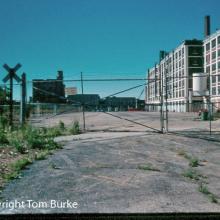
tb_cnw_deering_06_1990_1
This view looks south towards Diversey Parkway from the northeast side of the former Stewart-Warner Corporation headquarters. Stewart-Warner’s main building is to the west or right while the C&NW North Line is on the east or left. A spur curves in from the C&NW tracks across the gate and alongside the factory building. The Deering yard was to the left. The tall factory buildings in the background are on the south side of Diversey.Stewart-Warner was primarily a C&NW customer though the Chicago Switching District listing of industries from 1956 indicates that the Milwaukee road also serviced their south building at Clybourn and Wolcott via trackage rights via the Deering Line.
In 1987 Stewart-Warner was sold and in 1989 production was moved out of Chicago to lower cost facilities in Mexico and elsewhere, forcing the closure of this site. In 1993 the Stewart-Warner headquarters and factory complex burned down in a spectacular fire. Today condos occupy this land.
tb_cnw_deering_06_1990_1
Stewart-Warner was primarily a C&NW customer though the Chicago Switching District listing of industries from 1956 indicates that the Milwaukee road also serviced their south building at Clybourn and Wolcott via trackage rights via the Deering Line.
In 1987 Stewart-Warner was sold and in 1989 production was moved out of Chicago to lower cost facilities in Mexico and elsewhere, forcing the closure of this site. In 1993 the Stewart-Warner headquarters and factory complex burned down in a spectacular fire. Today condos occupy this land.
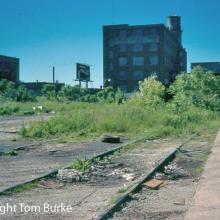
tb_cnw_deering_06_1990_2
The C&NW shared switching duties in the Deering Industrial Area with the Milwaukee Road. Just north of Diversey Parkway was the Deering Yard of the C&NW which was used for sorting cars for customers in this area. We are looking south towards Diversey in this photo. The building to the left of the C&NW North Line viaduct, in the upper right, was later converted to condos. The yard was replaced by new condo buildings.tb_cnw_deering_06_1990_2
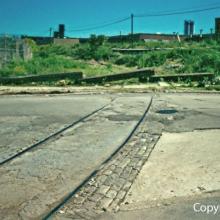
tb_cnw_deering_06_1990_3
Here’s where the C&NW entered the Deering site where it shared switching duties with the Milwaukee Road. The tracks leave the C&NW North Line on a gently curving ramp, traveling south across Wrightwood and Clybourn and towards us in this view. Note the cobblestone pavers from another era. Where the track crossed Clybourn there were the remains of frogs where they crossed double streetcar tracks into the 1980s. It appears that there were two tracks crossing Wrightwood at this spot at one time. I remember seeing a C&NW switcher traveling down the track on the left one evening during the summer of 1981 but did not have a camera with me unfortunately.tb_cnw_deering_06_1990_3
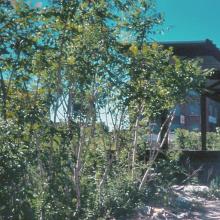
tb_cnw_deering_06_1990_4
At the southern end of the C&NW’s Deering Yard was this shed and platform. Potentially it was used as a team track for moving goods from boxcars onto platforms for transfer to trucks.tb_cnw_deering_06_1990_4
